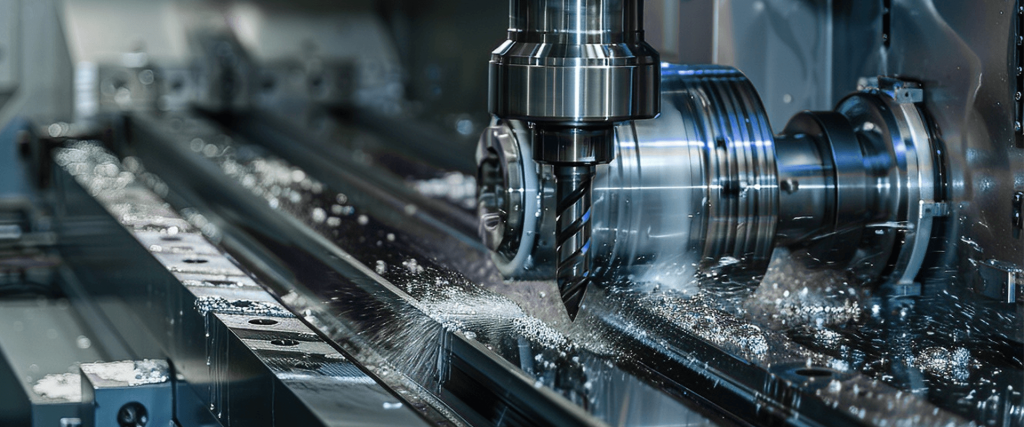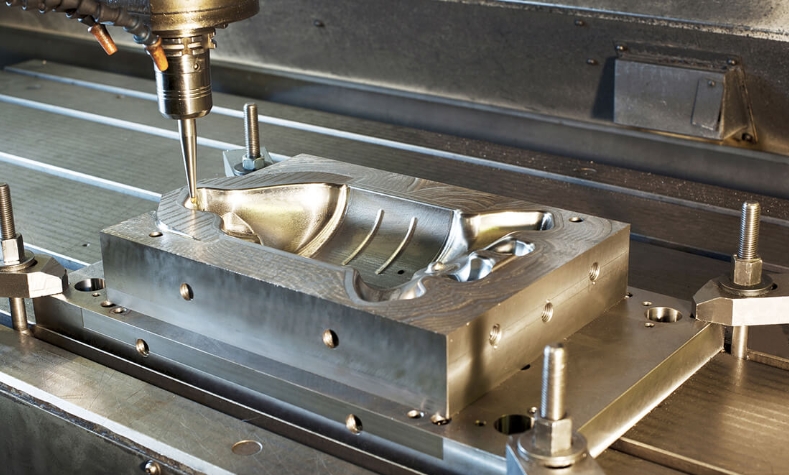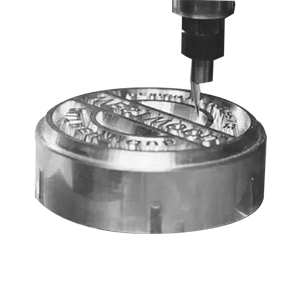CNC milling has revolutionized the manufacturing industry by providing a high level of precision, efficiency, and versatility. However, understanding the costs associated with CNC milling is crucial for businesses to make informed decisions and manage budgets effectively. This guide aims to explore the various costs involved in CNC milling, offering a comprehensive analysis for industry professionals.
Before we dive into the cost analysis, let’s first understand what CNC milling is. In this section, I’ll provide a clear definition and an overview of the CNC milling process, as well as a look at the different types of CNC milling machines available in the market.
What is CNC Milling:
CNC (Computer Numerical Control) milling is a machining process that utilizes computerized controls to manage the movement and operation of multi-point rotary cutting tools. This technology is used to gradually remove material from a workpiece, resulting in custom-designed parts with high precision.
CNC Milling Process:
The CNC milling process involves several steps, starting from the design phase and ending with the finishing of the final product. Here’s a brief overview:
- Design: Creating a CAD model of the part to be manufactured.
- Programming: Converting the CAD model into a CNC program.
- Setup: Preparing the CNC machine with the required tools and materials.
- Machining: The CNC machine executes the programmed instructions to create the part.
- Finishing: Post-processing steps such as deburring, polishing, or coating to achieve the final product quality.
Types of CNC Milling Machines and Their Average Prices
Understanding the different types of CNC milling machines and their associated costs is essential for budgeting and making informed decisions. Here is a breakdown of various CNC milling machines and their average prices:
Vertical Milling Machines
These machines have a vertically oriented spindle that moves up and down. They are commonly used for drilling and boring operations.
Average Price: $2,000 – $50,000
Horizontal Milling Machines
These machines have a horizontally oriented spindle, making them suitable for heavy-duty milling operations, including cutting grooves and slots.
Average Price: $5,000 – $100,000
5-Axis Milling Machines
Capable of moving the cutting tool in five different axes simultaneously, these machines are used for producing complex parts with high precision.
Average Price: $15,000 – $500,000+
CNC Routers
Typically used for cutting softer materials such as wood, plastic, and foam, CNC routers are versatile and often used in woodworking and sign making.
Average Price: $10,000 – $70,000
These prices can vary based on the specific model, features, manufacturer, and market conditions. When budgeting for CNC milling machines, it’s also important to consider additional costs such as installation, training, and maintenance.

Factors Influencing CNC Milling Costs
Several factors influence the overall cost of CNC milling. Understanding these factors can help businesses optimize their processes and manage expenses more effectively.
Machine Cost:
Initial Purchase Price: The cost of acquiring a CNC milling machine varies widely based on its capabilities, ranging from $20,000 for basic models to over $150,000 for high-end machines.
Types and Costs: Different CNC machines (e.g., 3-axis, 5-axis, multi-tasking machines) have varying costs based on complexity and functionality.
Operational Costs:
Electricity and Power Consumption: Energy costs depend on the machine’s power rating and operational hours. More advanced machines with higher power ratings typically consume more electricity.
Coolants and Lubricants: Regular use of coolants and lubricants is necessary to maintain tool performance and workpiece quality, adding to operational expenses.
Tooling Costs:
Types of Tools: Includes end mills, drills, reamers, and other cutting tools required for different milling operations.
Tool Wear and Replacement: Tools wear out over time and need to be replaced, adding to ongoing costs.
Labor Costs:
Operator Skills and Wages: Highly skilled operators command higher wages, impacting overall labor costs.
Training and Certification: Costs associated with training staff and obtaining necessary certifications to operate CNC machines proficiently.
Material Costs:
Different Materials: CNC milling can handle a variety of materials, including metals, plastics, and composites, each with different costs.
Cost Variations: Material prices fluctuate based on market conditions and material properties, affecting the overall cost of production.
Maintenance and Repair Costs:
Regular Maintenance: You need to keep up with scheduled maintenance to keep your machine running and producing parts.
Cost of Repairs: You’ll have to pay for unexpected repairs and buy spare parts, which can add up.
Software and Programming Costs:
CAD/CAM Software Costs: You have to buy the software and pay for annual licensing fees to design and program your CNC operations.
Programming Costs: You have to spend time and have the expertise to create and update your CNC programs, which can be expensive.
Setup and Calibration Costs:
Initial Setup Time and Costs: You have to spend time and resources getting your CNC machine ready to make parts.
Calibration for Precision: You have to calibrate your machine regularly to make sure it’s accurate and making good parts.

Cost Breakdown of CNC Milling
To give you a better idea of what it costs to do CNC milling, I’m going to break down the costs for a typical CNC milling project. I’ll also give you some examples and case studies to help you see what it costs in the real world.
Detailed Cost Breakdown:
Material Costs: $1,000 (based on the type and amount of material you’re using).
Machine Costs: $2,500 (depreciation on the machine and maintenance costs).
Tooling Costs: $500 (how much you’re spending on tools and how often you have to replace them).
Labor Costs: $1,000 (how much you’re paying the operator and how long it takes to set up the machine).
Operational Costs: $300 (electricity and coolant costs).
Software Costs: $200 (CAD/CAM software).
Comparing CNC Milling Costs with Other Machining Processes
Understanding how CNC milling costs compare to other machining processes can help you make better decisions. In this section, I’ll compare the costs of CNC milling to manual milling and other CNC processes like turning and grinding.
Cost Comparison with Manual Milling:
CNC milling usually costs more up front, but it’s cheaper in the long run because it’s more automated and efficient.
Cost Comparison with Other CNC Processes:
CNC Turning: Usually cheaper for cylindrical parts.
CNC Grinding: More expensive because it requires special equipment and processes.
Strategies to Reduce CNC Milling Costs
If you want to reduce the cost of CNC milling, you need to plan ahead and do things the right way. In this section, I’ll give you some strategies you can use to save money without sacrificing quality.
Design Considerations:
Simplify your designs to make them easier and faster to machine.
Optimize your part geometry to reduce the amount of material you have to remove and make your machining more efficient.
Optimization of Tool Paths:
Use tool paths that are efficient and reduce the amount of time it takes to machine your parts.
Use advanced software that can optimize your tool paths for you.
Material Optimization:
Use materials that are cost-effective and meet your requirements.
Minimize material waste by cutting your parts accurately and nesting them efficiently.
Energy Efficiency:
Use energy-saving practices like shutting off your machines when you’re not using them.
Invest in energy-efficient machines that use less power.
Tool Management:
Take care of your tools so they last longer.
Use high-quality, durable tools so you don’t have to replace them as often.
Process Automation:
Automate your processes to reduce labor costs.
Use robots and automated material handling systems to make your operation more efficient.
Batch Production:
Take advantage of economies of scale by making a lot of parts at once.
Reduce your per-part costs by making parts in batches.
How CNC Milling Costs Impact Different Industries
CNC milling costs impact different industries in different ways. Understanding these impacts can help businesses in these industries manage their costs more effectively.
Aerospace:
The aerospace industry relies heavily on CNC milling for producing high-precision components with complex geometries. The costs associated with CNC milling in this industry are influenced by:
- Material Costs: Aerospace components often use high-cost materials like titanium and specialized alloys, which increases the overall cost.
- Precision Requirements: The need for extremely tight tolerances and high surface finish quality increases the cost of machining.
- Regulatory Compliance: Adhering to strict industry standards and certifications adds to the cost of doing business.
Automotive:
In the automotive industry, CNC milling is essential for manufacturing engine parts, transmission components, and other critical elements. Key cost factors include:
- Mass Production: While CNC milling has higher setup costs upfront, it becomes cost-effective in high-volume production due to economies of scale.
- Material Selection: Using cost-effective materials without sacrificing quality helps manage costs.
- Cycle Time Reduction: Optimizing machining processes to reduce cycle time lowers labor and operational costs.
Medical Device Manufacturing:
Medical devices require high precision and adherence to strict regulatory standards. Cost impacts in this industry include:
- Material Costs: Biocompatible materials like medical-grade stainless steel and titanium are expensive.
- Precision and Quality: High precision and stringent quality control measures increase the cost of machining and inspection.
- Regulatory Compliance: Costs associated with FDA and other regulatory body approvals.
Electronics:
The electronics industry uses CNC milling for producing housings, connectors, and other components. Cost considerations include:
- Miniaturization: Machining small, intricate parts requires specialized tools and processes, increasing costs.
- Material Selection: Using high-performance materials like aluminum and copper affects overall costs.
- High Precision: The demand for tight tolerances and fine surface finishes adds to the cost of machining.
Comparing the Cost Impacts:
Different industries manage and mitigate CNC milling costs through different strategies:
Aerospace: Investing in advanced materials and precision machining technologies.
Automotive: Leveraging mass production and optimizing material selection.
Medical Devices: Focusing on precision and regulatory compliance while managing material costs.
Electronics: Balancing precision requirements with material efficiency.

What’s Coming Next in CNC Milling Cost Management
Advancements in technology and emerging trends will have a significant impact on CNC milling costs. In this section, we’ll explore those trends and how they could affect cost management.
Advancements in Technology:
- Additive Manufacturing Integration: Combining CNC milling with 3D printing to reduce material waste and machining time.
- Advanced Tooling: Developing cutting tools that are more durable and efficient to extend tool life and improve machining efficiency.
Adoption of Industry 4.0:
- Smart Manufacturing: Using IoT and real-time data analytics to optimize machine performance and reduce downtime.
- Digital Twins: Creating virtual models of CNC machines to simulate and optimize machining processes before production.
Predictive Maintenance:
- Condition Monitoring: Using sensors to monitor machine health and predict maintenance needs, reducing unexpected downtime and repair costs.
- AI and Machine Learning: Implementing AI algorithms to analyze machine data and accurately forecast maintenance requirements.
Final Thoughts:
Effective strategies for managing CNC milling costs include optimizing designs, tool paths, and materials, investing in energy-efficient machines, and leveraging automation. Future trends like Industry 4.0 and predictive maintenance promise further cost reductions and efficiency improvements.
FAQs
How can I reduce the cost of CNC milling in my shop?
Strategies include simplifying designs, optimizing tool paths, being more efficient with material, saving energy, managing tools, automating, and running more production.
Is CNC milling more cost-effective than other machining processes?
CNC milling can be more cost-effective depending on the complexity and volume of the parts you’re making compared to manual milling and other CNC processes like turning and grinding.
What are the long-term cost benefits of investing in CNC milling technology?
Long-term benefits include more precision, lower labor costs, more efficiency, the ability to do complex geometries, which all lead to cost savings and better production capabilities.











